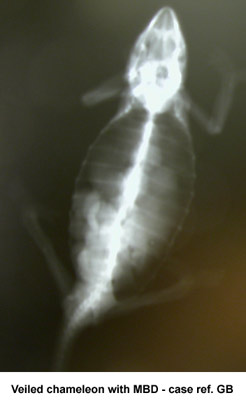|
|
This
is one case from a series of reports compiled as part
of an investigation into photo-kerato-conjunctivitis,
possibly occurring as a result of excessive low-wavelength
UVB radiation under certain brands of fluorescent
UVB lamp.
Please
do not view this one case without reference to the
whole report of which it is a part.
|
Case
History : GB
(Italy) - Veiled Chameleon (Chamaeleo calyptratus)
Case
examined by Michele Buono DVM (Turin, Italy)
A
female Veiled Chameleon (Chamaeleo calyptratus) was
presented to the veterinary clinic in July 2007 for anorexia
and reluctance to move.
The
chameleon was housed in a glass terrarium, size 60cm by
100cm by 60cm (24in by 39in by 24in); inside there were
branches for climbing, and a plastic rock waterfall. There
was a UVB fluorescent tube, but this was outside of the
glass.
 On
clinical examination, the animal had a severe metabolic
bone disorder (MBD) and x-rays showed a large number of
eggs. (Figure 1.) On
clinical examination, the animal had a severe metabolic
bone disorder (MBD) and x-rays showed a large number of
eggs. (Figure 1.)
Therapy
was begun with oral calcium borogluconate with dextrose
(ATI) at a dosage of 100mg/kg and oral calcediol
(25-hydroxy-vitamin D3, 1.5mg/10ml) (Didrogyl, Bruno
farmaceutici SpA) at a dosage of 200IU/kg every week.
A
new ZooMed Reptisun 10.0 Compact Lamp was installed inside
the terrarium and switched on for 12 hours a day. This was
positioned at about 15cm (6in) from the animal.
After
3 days the chameleon closed its eyes and spent all the day
unmoving on a branch.
The
owner was advised to replace the lamp with a ZooMed Reptisun
5.0 Compact Lamp and reduce the exposure to 6 hours a day.
After
this change, the chameleon opened its eyes again and after
15 days of therapy, it began to eat again.
Two
months after first presentation, the chameleon was re-examined.
Its eyes were normal. Its condition had improved; it was
able to walk, although with some deviation of the hind limbs,
and x-rays showed an apparent improvement in bone mineralisation.
|


















 On
clinical examination, the animal had a severe metabolic
bone disorder (MBD) and x-rays showed a large number of
eggs. (Figure 1.)
On
clinical examination, the animal had a severe metabolic
bone disorder (MBD) and x-rays showed a large number of
eggs. (Figure 1.)